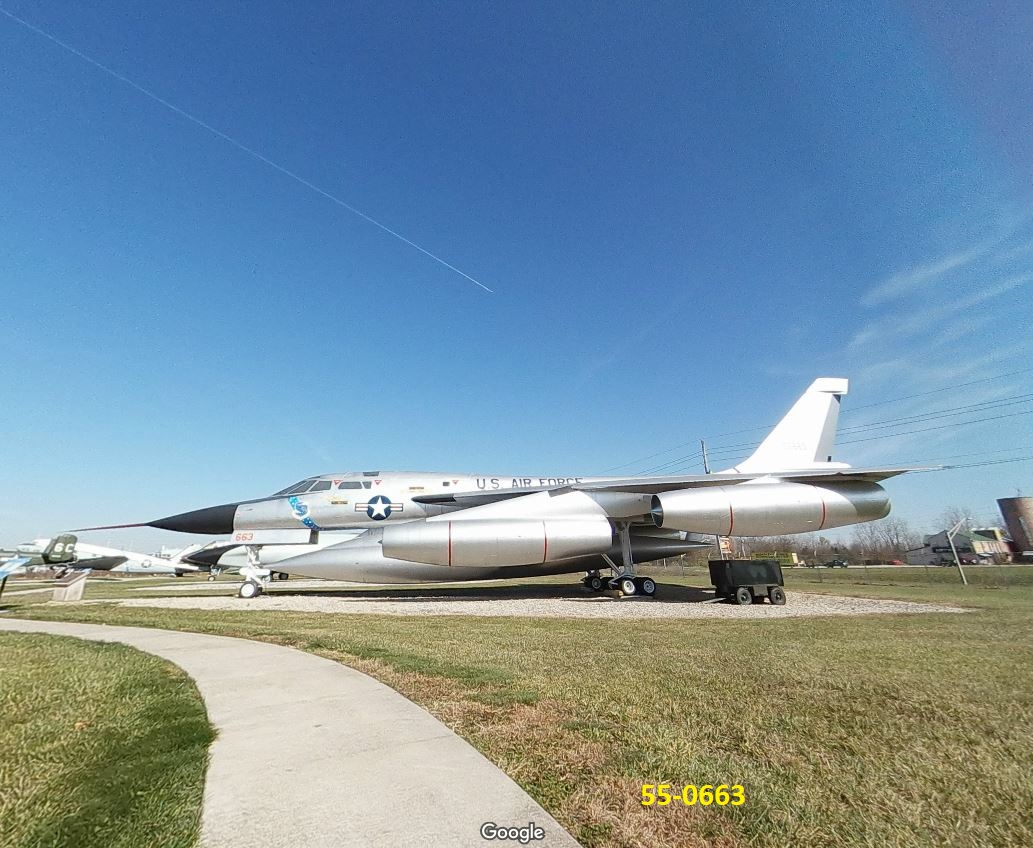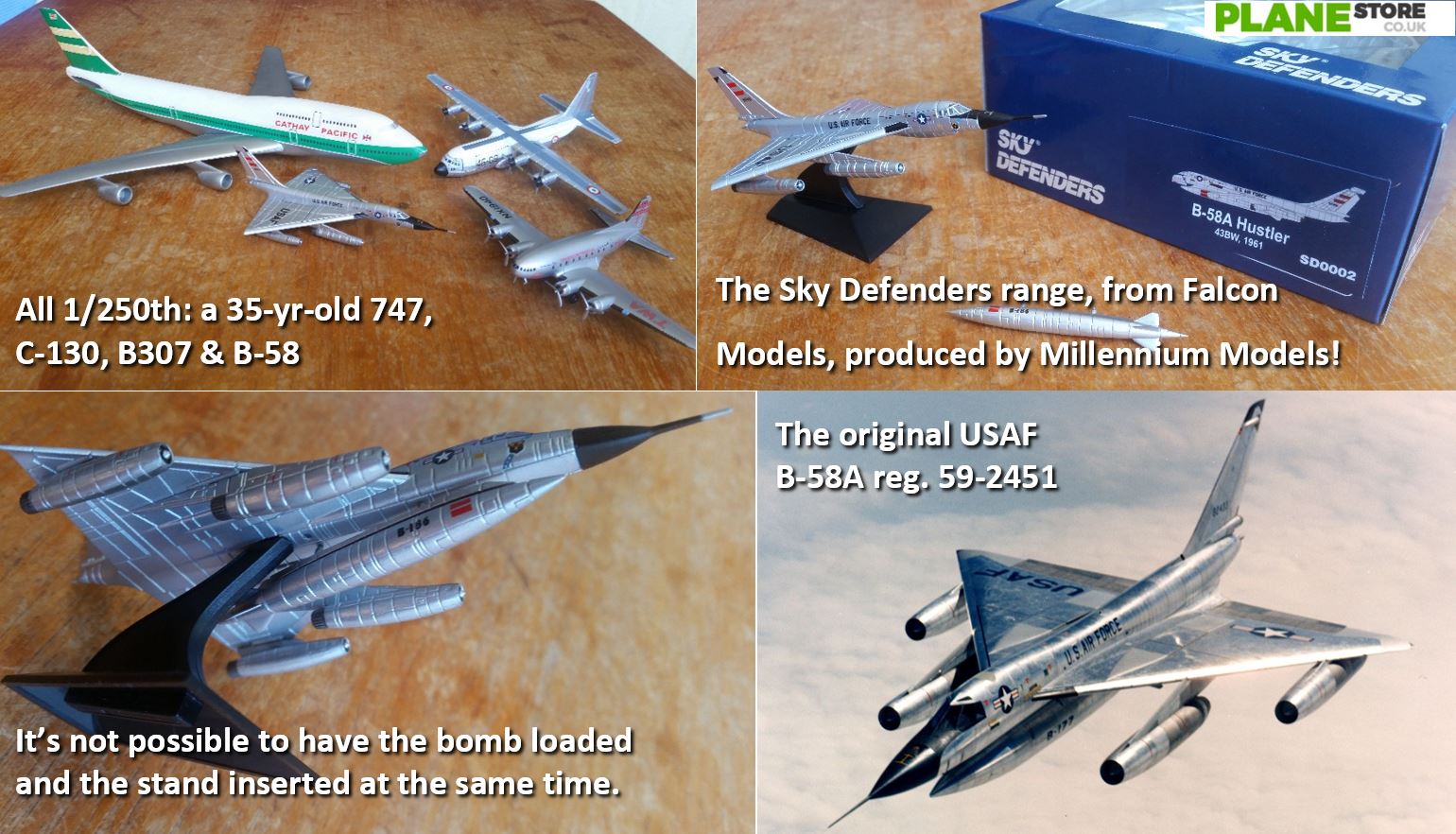Convair B58 Hustlers - The Convair B-58 Hustler, designed and manufactured by American aircraft manufacturer Convair, was the first active bomber capable of flying at Mach 2.
The B-58 was developed in the 1950s for the United States Air Force (USAF) Strategic Air Command (SAC). To achieve the high speeds required, Convair chose the triangular wing design used by modern fighter jets such as the Convair F-102. The bomber had four Geral Electric J79 engines. It has no bomb bay: it carries nuclear weapons and fuel in a combined bomb/fuel bay under the fuselage. Later, four external hardpoints were added, allowing it to carry five guns.
Convair B58 Hustlers
The B-58 entered service in March 1960 and for a decade flew with two SAC bomber wings: the 43rd Bomb Wing and the 305th Bomb Wing.
Convair B 58 Hustler By Grandpaphil
The flight was considered difficult and caused a high workload for the three crew members. Designed to replace the subsonic Boeing B-47 Stratojet strategic bomber, the B-58 is known for the sonic boom heard by the public on the ground when passing overhead during supersonic flight.
The B-58 was originally designed to fly at high altitudes at supersonic speeds to avoid Soviet interceptors, but with the Soviet Union's introduction of high-altitude surface-to-air missiles, the B-58 was forced to take over the role of pilots. low-altitude strikes that severely limit its range and strategic value. It was never used to deliver conventional bombs. The B-58 was more expensive than other bombers, such as the Boeing B-52 Stratofortress, and required frequent mid-air refueling. The B-58 had a high casualty loss rate. These factors led to a relatively short t year combat career. The role of the B-58 was replaced by the smaller-wing FB-111A.
The B-58 was a General Bomber Study (GEBO II) launched in February 1949 by the Air Force Research and Development Command (ARDC) at Wright-Patterson Air Force Base, Ohio, to develop supersonic, long-range flight. guided bomber. The ARDC seeks the best quantitative data available, encouraging the industry to develop its own solutions to achieve these goals.
Design work on the proposed bomber began less than two years after sustained supersonic flight was achieved.
Ai Convair B 58/tb 58 Hustler
According to aviation writers Bill Gunston and Peter Gilchrist, while some military officials are interested in the future use of supersonic bombers, others are interested in the propulsion systems and materials science required to operate at supersonic speeds and the relatively high cost of supersonic bombers. fuel consumption is skeptical of its subsonic counterparts.
Despite skepticism, many contractors have bid for GEBO II, which is seen as a major step forward for a development contract. These include Boeing, Convair, Curtiss, Douglas, Martin and North American Airlines. Most applications were relatively simple, unambitious and overly detailed.
Convair, which built the XF-92A and other delta-wing fighters, evaluated swept and half-triangular wing configurations and settled on a delta wing that offered better internal space for support systems and fuel. It also provided low wing loading for the size of the fuselage, allowing supersonic flight at 50,000 to 70,000 ft (15,000 to 21,000 m) in the mid-stratosphere.

Most configurations have explored delta wings paired with a relatively thin fuselage that accommodates two crew and is powered by a pair of jet engines.
Image Of The Convair B 58 Hustler
Designated the FZP-110, Convair's offering was an aggressive two-seat triangular bomber powered by three Geral Electric J53 turbojet engines. Performance estimates include a speed of 1,000 mph (1,600 km/h) and a range of 3,000 miles (4,800 km).
A key design feature is the storage of consumables, including weapons and most of the fuel, in a large external pod, allowing for a smaller airframe. In January 1951, Convair submitted the FZP-110 proposal, which was received later than other competing bids.
In December 1951, a revised FZP-016 proposal was submitted, which removed the third aft engine, increased the power of the remaining two engines, and added a third crew member to operate the defense system.
The Air Force selected Boeing's MX-1712 and Convair's MX-1626 designs for Phase 1 studies. During this time, Convair used direct development by General Electric to replace its two large J53 engines with four smaller J79 engines optimized for supersonic flight.
Convair B 58 \
The directly formulated area rules were also applied to the design, resulting in an aerodynamically re-contoured and thinner fuselage. After the improvements, Convair refined their MX-1964 reissue.
According to Gunston and Gilchrist, Boeing's offer was considered equally good, but their own contract to manufacture the Boeing B-52 Stratofortress affected the competition.
In December 1952, the Convair was selected to meet the first General Operating Requirements (GOR) for the new SAB-51 (Supersonic Bomber) and SAR-51 (Supersonic Reconnaissance) standards, supersonic bombers. In February 1953, the Air Force awarded the design contract to Convair on December 10, 1952, designated the B-58.

The B-58 program differs from previous military aircraft programs and is now recognized as the first weapons system contract.
Test Pilots With B 58 Hustler Bomber At Convair, Fort Worth
Under this agreement, Convair will act as the prime contractor for all elements of the project, not just the aircraft. Convair must design or subcontract more than a million units of everything related to the operation of the aircraft, from engines to training manuals, spare parts and software.
Earlier, the contract was amended to produce a pair of XB-58 prototypes, 11 YB-58A pre-production aircraft, and 31 mission bearings, including a drop bomb, a rocket-guided bomb, and a reconnaissance unit. cockpit and electronic reconnaissance bearing.
The procedure is carried out with a high degree of security: until it is released, its shape or basic configuration is unknown to an unauthorized person.
On November 11, 1956, a service flight took place. The prototype exceeded Mach 1 for the first time on December 30 of that year.
Convair B 58 Hustler Blueprint
A total of 116 B-58s were built: 30 experimental and 86 production B-58As. Most of the flight tests were later upgraded to operational standards. Eight are equipped with TB-58A simulators.
Most people never get past the drawing board because orders are made before they decide to break multiple contracts. The B-58B, B-58C, B-58D, and B-58E variants were discontinued before any production aircraft were completed. In the late 1960s, several improvements were developed and introduced to the existing fleet, such as silver bullet racks (known as the multi-gun feature) and additional propellers.
The Convair B-58 Hustler is a high-speed strategic bomber capable of reaching Mach 2 at high altitude. It had a large delta wing with a leading edge of 60° and was powered by four Geral Electric J79-GE-1 turbojet engines. Although its large wings produced relatively low wing loading, it was well suited for low altitude and high speed flight. The crew compartment, wheel well and electronics compartment are all pressurized and air-conditioned to avoid the heat generated when cruising at Mach 2. One of the first widespread applications of aluminum cellular panels, the B-58 bonded inner and outer aluminum skins to aluminum honeycomb or fiberglass honeycomb.

The structure itself accounted for 13.8 percent of the total weight of the aircraft, a very low figure for the era, and the wings were also considered very thin. Several key features of the engine, including the pilot and air intake, were designed to differ from existing aircraft under the guidance of aerodynamicists.
B 58 Hustler Hi Res Stock Photography And Images
In particular, the intake uses movable conical rods that are fully rearward on the ground to maximize air intake at low speeds and move forward at high speeds to minimize annular gap. This motion is automatically controlled, but if one input fails, there is significant noise and asymmetric force.
The B-58 is operated by a crew of three: a pilot (aircraft commander or "AC"), a radar navigator/bombardier (navigator or "Nav"), and a defense systems operator (DSO).
They sit in separate tandem cabins. The cockpit windows are very deep and are considered the basic conventional cockpit for large multi-engine aircraft.
The defense systems operator was equipped with a variety of systems that Gunston and Gilchrist described as the most sophisticated of any aircraft at the time. The space allocated to the crew is generally considered cramped and claustrophobic, despite the fact that it is about half of the internal volume of the fuselage.
Convair B 58 Hustler Banque De Photographies Et D'images à Haute Résolution
Later versions of the B-58 provided a new launch pad that could eject each crew member at Mach 2 at an altitude of 70,000 feet (21,000 meters). Unlike standard ejection seats of the period, the protective ejection seat cover covered the seat and handle with attached oxygen tanks, allowing the pilot to continue flying even if he was "broken" and ready for immediate evacuation. The capsule floats; the crew can open the hatch and use it as a life raft.
It became operational in 1963 and the bear was the first living thing to survive a supersonic ejection.
Electronic controls were ambitious and advanced for their time. The navigator and DSO cockpits have a roll-up instrument panel with warning lights and buttons, and automated voice messages and warnings from the magnetic tape system can be heard through the helmet mount. research period

Convair liner, convair, convair 880, convair b58 hustler, b58, convair 990, convair 580, convair coolers, convair 440, convair tradewind, hustlers, convair b58
0 Comments